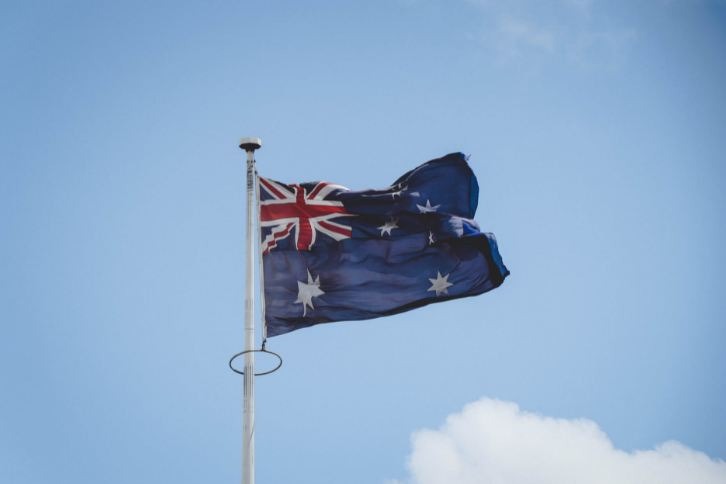What Side of the Road Does Australia Drive On? Driving in Australia Explained
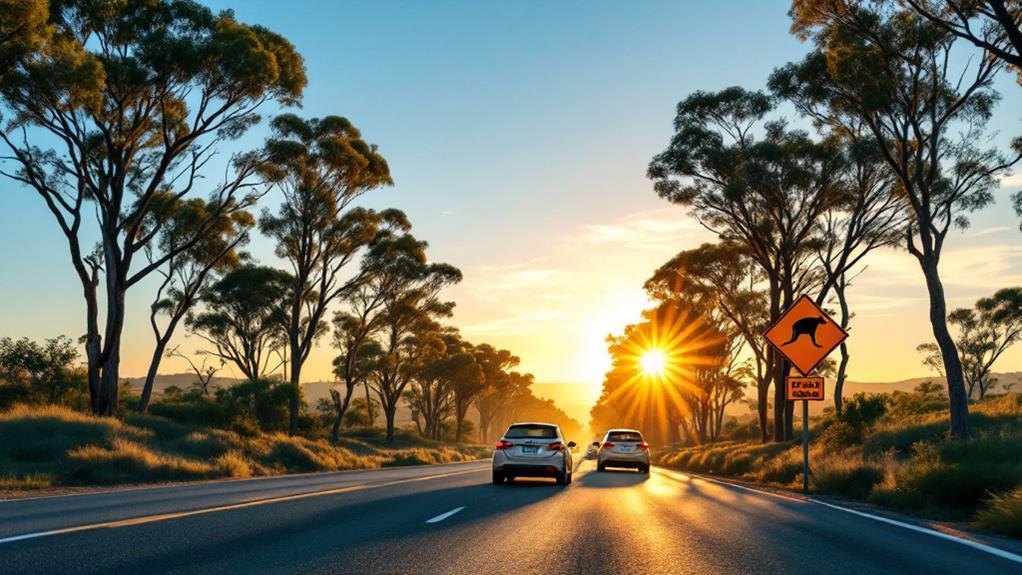
When driving in Australia, you stick to the left side of the road, a practice inherited from British colonial influence. Most vehicles have their steering wheels on the right side, making left-lane driving intuitive. You should always give way to the right at roundabouts and keep in mind that speed limits differ between urban areas and highways, typically capping at 50 km/h in cities and 110 km/h on highways. Don't forget, using a mobile phone without hands-free features is illegal. If you're curious about licenses, toll roads, or planning a scenic road trip, there's more helpful information to uncover.
Driving on the Left
Why does Australia drive on the left side of the road? This practice dates back to British colonial influence, ensuring consistency across the nation. When driving in Australia, you'll notice that the majority of vehicles are equipped with right-side steering wheels, designed specifically for left-hand traffic. This setup might seem unusual if you're used to driving on the right, but you'll quickly adapt with a little practice.
Navigating roundabouts requires particular attention. You must give way to vehicles on your right, following the clockwise direction of traffic. It's essential to keep this in mind as you adjust to Australia's road rules. Speed limits are also critical to observe; urban areas typically have limits of 50 km/h, while highways can allow speeds up to 110 km/h. Be cautious, as fines for speeding are strictly enforced.
If you're a foreign driver, remember you can use an English driving license for up to three months. However, if your license isn't in English, an International Driving Permit (IDP) is necessary. This is especially significant when renting cars. With these guidelines, your Australian driving experience should be smooth and enjoyable.
Road Rules Overview
When driving in Australia, it's vital to understand the key road rules to guarantee a safe and legal trip. Initially, remember to drive on the left side of the road. This might feel unusual if you're used to driving on the right, but it's imperative for staying on the right side of the law.
Here are some key road rules to keep in mind:
- Seatbelts and Child Restraints: Seatbelts are mandatory for everyone in the car, and children under seven must use appropriate child restraints. This rule is strictly enforced, so make sure everyone is buckled up.
- Blood Alcohol Limit and Random Breath Tests: The legal blood alcohol limit is 0.05% for fully licensed drivers. Police regularly conduct random breath tests, so it's best to avoid drinking if you plan to drive.
- Mobile Phone Use: Using a mobile phone while driving is illegal unless it's hands-free. Even at traffic lights, you can't use your phone without a hands-free setup.
- Speed Limits in Urban Areas: Typically, it's 50 km/h in urban areas and drops to 40 km/h in school zones. Keep an eye on signs, especially if you've hired a car unfamiliar with local speed regulations.
Navigating Roundabouts
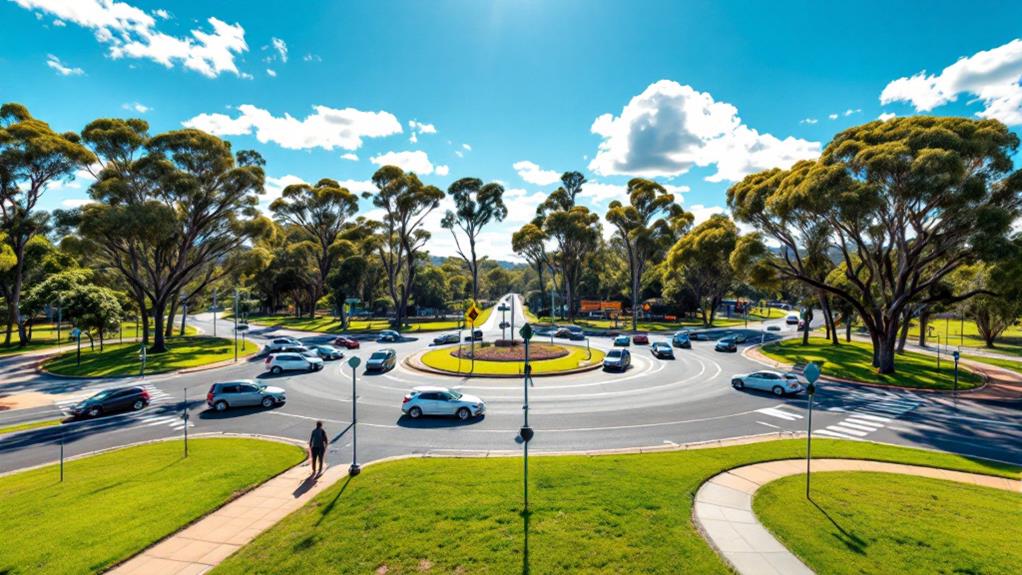
Maneuvering roundabouts in Australia requires a clear understanding of the rules to guarantee safety and compliance. As you approach a roundabout, keep in mind that it operates in a clockwise direction. You must give way to vehicles coming from the right and always yield to those already inside, as they have the right of way. This guarantees a smooth flow of traffic and prevents accidents.
Before entering, it's critical to signal your intended exit direction. Proper signaling lets other drivers anticipate your movements, reducing confusion. Pay attention to road markings, which guide you on lane usage for different exits. These markings help you position your vehicle correctly and choose the appropriate lane when multiple exits are available.
Failure to adhere to these rules can lead to fines and demerit points on your driving record, affecting your ability to drive legally. Understanding and respecting the regulations surrounding roundabouts assures not only your safety but also the safety of others on the road. By observing these guidelines, you'll navigate Australian roundabouts with confidence and competence, maintaining the flow of traffic and adhering to the law.
Licenses and Permits
Maneuvering the intricacies of driving licenses and permits in Australia is vital for international visitors. If you're planning to drive, knowing the regulations and local laws is significant. Overseas drivers can use their English-language driving licenses for three months. However, if your license isn't in English, you'll need an International Driving Permit (IDP) to guarantee it's valid. In the Northern Territory, if your stay exceeds three months, obtaining a local license becomes mandatory.
Here are some key points to keep in mind:
- Document Fundamentals: Always carry your driving license and photo ID, like a passport, especially if your license doesn't include a photo.
- State and Territory Regulations: Each state has its own rules regarding licenses, so check the local laws before traveling to confirm compliance.
- Car Rental Protection: When renting a car, companies like Turo offer protection plans, including up to $20,000,000 in legal liability, providing peace of mind during your trip.
- Extension Considerations: If planning to stay longer and drive, research the specific requirements for extending your driving privileges in your state or territory.
Speed Limits Explained
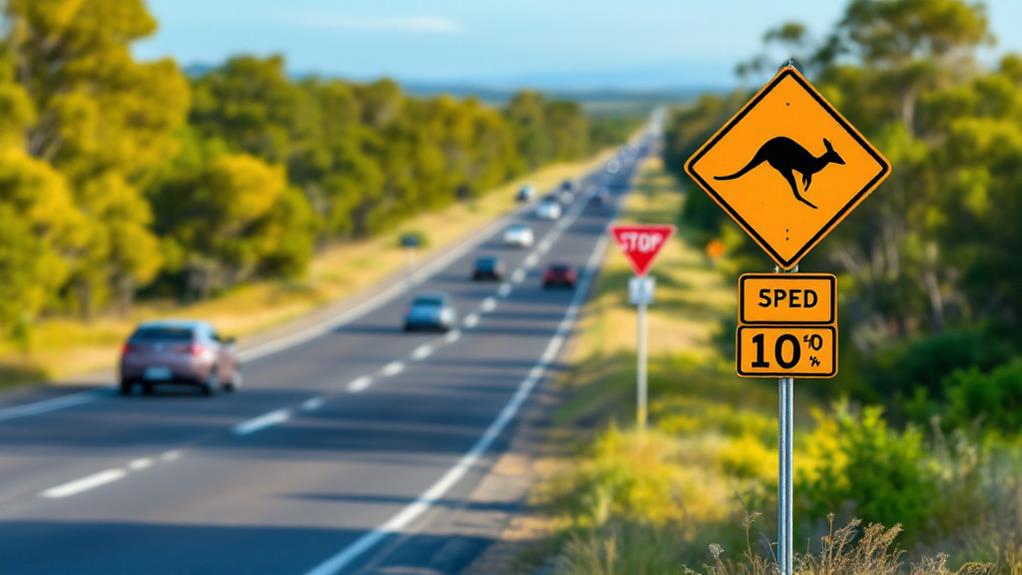
Understanding driving licenses and permits is just one piece of the puzzle when driving in Australia; knowing and adhering to speed limits is likewise significant. In urban areas, speed limits are generally set at 50 km/h, guaranteeing safety in lively environments. As you venture out onto rural roads, you'll find that the maximum speed limit typically rises to 100 km/h, with some highways allowing speeds up to 110 km/h. It's vital to be aware of these changes as you navigate different regions.
Particularly essential are school zones, where speed limits are reduced to protect children. These zones have limits ranging from 40 km/h and can drop to as low as 25 km/h in South Australia during specified hours. Exceeding speed limits in these areas or elsewhere can lead to hefty fines, from $150 for minor infractions to over $4,000 for severe violations.
Moreover, accumulating demerit points from speeding can result in a suspended license. Speed cameras, both fixed and mobile, are common throughout Australia, often hidden to guarantee compliance. Staying mindful of speed limits not only avoids fines and demerit points but also keeps everyone on the road safer.
Fueling Your Vehicle
When you're driving in Australia, fueling your vehicle is an essential part of your trip. Most vehicles will require unleaded petrol, but if you're traversing remote areas with a 4WD or campervan, diesel might be more prevalent. Petrol stations, or "servos," are your go-to spots for fuel, snacks, and restrooms. Many urban servos operate 24/7, guaranteeing you can refuel anytime. However, rural areas may not offer the same convenience, so planning ahead is critical. Here's what you should know:
- Fuel Types: Unleaded petrol is the norm, but Opal fuel is available in some Aboriginal communities. It's designed with environmental considerations in mind.
- Payment: Self-service fuel pumps require you to pay inside the store after filling up. Keep cash or a card handy to streamline your visit.
- Fuel Availability: In rural areas, petrol stations can be sparse. Always check your route for fuel stops to avoid running on empty.
- Vehicle Considerations: If you're in a 4WD, especially in remote locations, diesel may be your best option due to its availability and efficiency.
Planning ahead will guarantee a smooth experience throughout your Australian adventure.
Handling Toll Roads
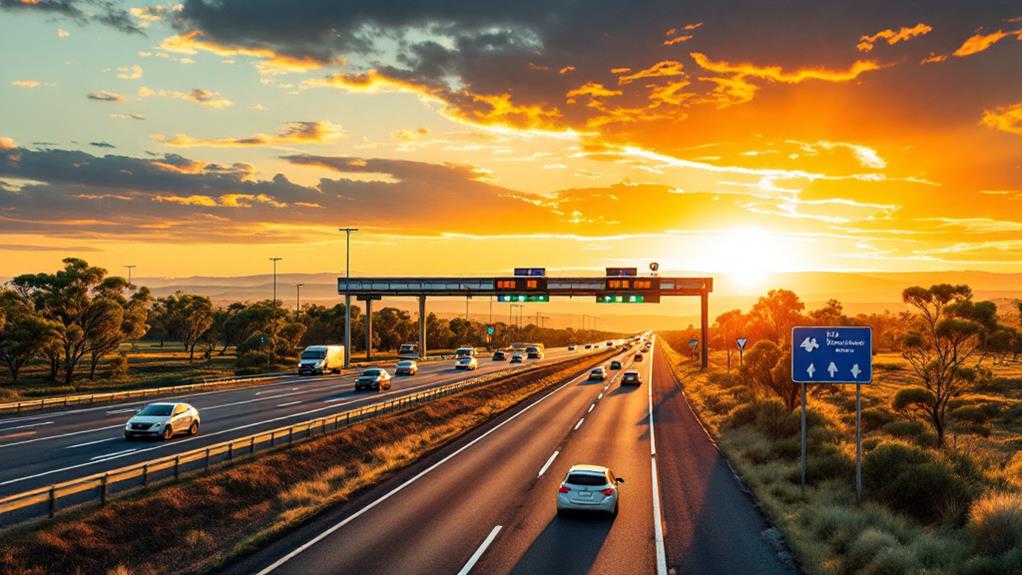
Maneuvering toll roads in Australia might seem intimidating initially, but it's quite straightforward once you understand the system. The country uses electronic tolling, meaning you'll need an E-Tag attached to your vehicle. This electronic device automatically deducts toll charges as you pass through. In major cities like Sydney and Melbourne, toll roads are prevalent and can considerably reduce your travel time, but you'll need to be aware of the extra costs involved.
If you're driving a rental car, check if it comes equipped with an E-Tag. Most do, but it's always wise to confirm and familiarize yourself with the toll payment process outlined in your rental agreement. Each toll road has specific toll costs depending on the distance traveled, so before you hit the road, research the charges on your planned route to avoid surprises.
For visitors, some toll roads offer visitor passes. These passes simplify the payment process, especially if you're in Australia for a short stay. By understanding how toll roads work and preparing in advance, you can enjoy a smoother driving experience without the hassle of unexpected fees.
Safety and Legalities
Driving in Australia requires adherence to specific safety and legal standards that secure everyone's well-being. Primarily, you'll need to get accustomed to driving on the left side of the road. The steering wheel is on the right, which can initially feel strange if you're used to the opposite setup.
To guarantee safety, keep the following in mind:
- Seat Belts and Child Restraints: It's mandatory for everyone in the vehicle to wear seat belts. For children under seven, use approved child restraints to keep them secure.
- Alcohol and Random Breath Testing: The legal blood alcohol limit for fully licensed drivers is 0.05%. Police conduct random breath testing to enforce this rule, so it's vital to stay within the limit.
- Mobile Phone Usage: Using a mobile phone while driving is illegal unless you're employing a hands-free device. For emergencies, pull over safely before making a call.
- Speed Limits and Penalties: Speed limits vary from 50 km/h in urban areas to 100-110 km/h on highways. Penalties for speeding differ by state, so always stay alert to posted signs.
Adhering to these rules not only avoids penalties but also guarantees a safer driving experience for everyone.
Road Trip Essentials
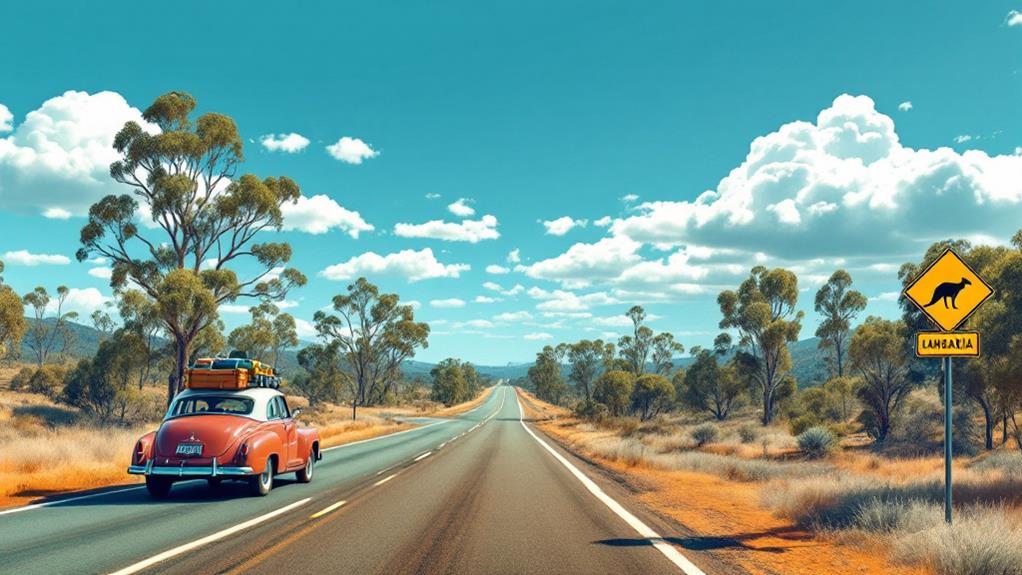
Setting out on an Australian road trip is an adventure that requires thorough preparation to guarantee a smooth trip. One of the road trip basics is a reliable map or GPS, as mobile coverage can be patchy in rural and outback areas. Knowing your vehicle's fuel type is vital, especially if you're driving a 4WD or campervan. Some remote petrol stations only offer specific fuels like diesel or Opal, so plan accordingly.
Always pack an initial aid kit, spare tire, and a set of emergency supplies. Breakdowns can happen, and in remote outback areas, they might lead to long wait times for help. Water is another significant consideration; carry at least 10 liters per person, per day, plus extra reserves to stay hydrated when services are few and far between.
When planning overnight stays, familiarize yourself with local camping options such as caravan parks and national park campgrounds. These sites often provide key amenities that can improve your adventure. Proper preparation guarantees that your Australian road trip is not only thrilling but also safe and comfortable, allowing you to focus on the incredible landscapes and experiences ahead.
Scenic Routes to Explore
Once you've packed your road trip necessities, it's time to uncover some of Australia's most breathtaking scenic routes. Regardless of if you're a seasoned road trip enthusiast or a casual traveler, these routes offer unforgettable experiences with stunning landscapes and coastal views.
- Great Ocean Road: Located in Victoria, this renowned scenic route features dramatic coastal views, including the iconic Twelve Apostles rock formations. It's a must-see for those who appreciate ocean panoramas and rugged cliffs.
- Grand Pacific Drive: South of Sydney, this route offers stunning vistas of cliffs, beaches, and the iconic Sea Cliff Bridge. It's perfect for those who enjoy a blend of natural beauty and engineering marvels, making it a favorite among nature lovers.
- Great Barrier Reef Drive: Near Cairns, this drive provides picturesque views of the reef and coastline. Ideal for nature enthusiasts, it offers a unique opportunity to investigate the lively marine life of the Great Barrier Reef.
- Gibb River Road: In Western Australia's Kimberley region, this rugged 4WD adventure route is known for its remote beauty and stunning landscapes. Tasmania's scenic loop also showcases diverse terrains, offering a magical expedition through lush forests and breathtaking vistas.



